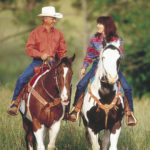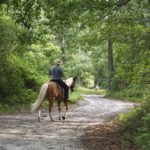January 2012–Joell Dunlap was struggling to make her instructions carry across the riding ring, above the din of a howling wind, to her young student who couldn?t quite grasp the concept of holding tighter to reins.

After several minutes of watching the child and horse flail, Dunlap strode across the riding ring, and in a loud, commanding voice, said, ?I just really need you to hold your right rein!?
And the child, diagnosed with autism from an early age, and so sweet and eager to please, leaned over and whispered in her ear, ?I’m trying.?
When she describes that moment, Dunlap?s eyes well up; her voice catches.
For it was on that very frustrating day at her riding academy in Half Moon Bay, Calif., that her life?s work came into sharper focus. The quick exchange with her determined young student underscored the full meaning of the name she had given her riding stable and federal nonprofit, The Square Peg Foundation.
In Dunlap?s world, ?square pegs? are the people and horses who don’t fit neatly into a one-size-fits-all society. But, working together, horse and rider teams help one another in critical, life affirming ways.
?There are so many things about riding that are valuable. Sometimes it’s the trust between the horse and rider that’s most important; sometimes it’s about helping the rider to feel powerful, or accomplished, or really elegant,? she says. For an autistic or special needs child, a ride on a horse can provide a different glimpse of the world, a broader perspective on life, she adds.
Dunlap began teaching special needs children to ride in 2001, while she maintained full-time work as a Thoroughbred exercise rider and trainer.
By 2004, when Square Peg Foundation was officially founded as a certified nonprofit, Dunlap began to delve more deeply into the connection between special needs students and the many off-track Thoroughbreds she worked to retrain and re-home.
?By the time I named my foundation Square Peg, I had begun to realize that when you try to force the fit, whether you’re trying to make a racehorse run who doesn’t want to, or you’re trying to make a special needs child sit still in a classroom, it doesn’t work,? she says.
At her stable, it matters little how well a special-needs child can ride; what’s important is only that he or she derives some measure of positive stimulation from the experience. ?And if a Thoroughbred can no longer run or be competitive in the world of professional racing, he can still be a star at Square Peg by virtue of his personality and heart.
?When an 1,100 pound animal is willing to respond to a child who is only capable of making a one-syllable command, you?ve got a pretty dynamic horse,? she says.
A favorite on her farm is Hank, a Thoroughbred who raced under the name My Cheatin? Heart.
Hank recently served as an ambassador for The Square Peg Foundation and a therapeutic riding technique that helps a broad spectrum of autistic patients. And he did it in a big way.

Outfitted with rubber shoes and a western saddle, Hank strode bravely onto the slippery, concrete floor of the San Jose Convention Center to participate in the Abilities Conference last November.
Beneath bright, florescent lights, Hank walked before crowds of onlookers and was approached by wheelchair-bound people, as he demonstrated a therapeutic riding method for all levels of autistic children. The HorseBoy Method, which Rupert Isaacson created, offers kids the opportunity to sit atop a horse, while a skilled rider pilots the animal around at a walk, trot or canter.
Sitting in the lap of a coach, astride a powerful equine, the rhythmic movement stimulates the child?s brain, often eliciting humming and singing from the child.
?All of a sudden, the ride is getting them to see outside of themselves, and to develop a new perspective on the world,? Dunlap says. ?You can do this with a kid who doesn’t speak at all, or with a child who?s highly verbal, but needs to settle down.?
After Hank helped demonstrate the method, he wowed the audience with newly acquired skills of his own. On cue, Hank smiled, lifted his legs, and bowed for an audience that was charmed by a horse who hadn?t fit so neatly into life as a racehorse.
But, on this day, he shined as an ambassador for Thoroughbreds and The Square Peg Foundation.
He was a star of the three-day conference. Unfazed by the screeching feedback from a blaring sound system, the flashbulbs, or the slippery floor, the horse with dashing good looks smiled at the crowd from 20 paces and dealt with aplomb any distraction that came his way.
?When we first walked in, a crowd was playing wheelchair lacrosse,? Dunlap says. ?We gave him a minute to take it in and he?d breath out and lean toward us. I was scared to death. But he just went with it.?
Hank, who is also a skilled polo player, has a level head in so many settings. He is often asked to deal with oncoming horses and mallet-wielding riders.
?And if he is scared, he knows he can lean on humans to help him,? Dunlap says.
And Hank and other horses in the Square Peg Foundation program are only too willing to give joy to the very special people, like the little girl who tried so hard to hold the reins.
?Our Thoroughbreds exceeded our expectations that day at the San Jose Convention Center,? Dunlap says in a published report. ?They smiled on cue, bowed for the crowd, and let numerous children with struggles such as blindness, cerebral palsy ? and other developmental challenges, pet them.
?They were ambassadors of freedom and strength and power for people to whom life has dealt a different hand.?





